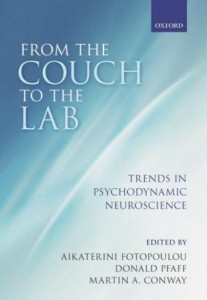Origins: What is Neuropsychoanalysis?
Traditionally, interdisciplinary dialogue between psychoanalysis and biological or, cognitive sciences was seen as irrelevant, if not impossible, despite some rare, early attempts (e.g. Pribram & Gill, 1976). However, since the 80s there has been a marked increase in exchange of ideas between neuroscientists and psychoanalysts. This dialogue was pioneered and uniquely shaped by Mark Solms in the 1980s and 1990s. In 2000 he founded the International Society of Neuropsychoanalysis; a small, yet influential group of internationally recognised scientists and psychoanalysts that joined forces to create a forum of interdisciplinary dialogue (see www.neuropsa.org; and http://www.npsafoundation.org). Neuropsychoanalysis was founded with the general aim of creating a forum in which neuroscience and psychoanalysis can compare perspectives on topics of mutual interest. At a general level it aims to consider how empirical findings and neuroscientific theories can be enhanced by metapsychological knowledge derived from subjective, clinical observation and vice versa. At a more specific level, it aims to identify a model and a method of brain functioning that respected and accommodated the psychodynamic nature of mental phenomena, while also exposed their neurological nature and structure to scrutiny.
Since then such efforts of a mutually respectful, interdisciplinary dialogue have multiplied. Why do we need another, similar interdisciplinary field then?
Focus: What is Psychodynamic Neuroscience?
Several research groups internationally have been conducting research that aims to be metapsychologically constrained and psychoanalytically inspired (see the neuroscientific work of Peter Fonagy, Georg Northoff, Jaak Panksepp, Howard Shevrin, Mark Solms and Oliver Turnbull to name but a few excellent examples; see the edited volume ‘From the Couch to the Lab’ for more examples). My own research priorities have also been determined by the heuristic, integrative and constraining potential of metapsychology (e.g. Fotopoulou et al., 2010; Fotopoulou, 2010; Fotopoulou, 2008 see publications). To different degrees and in different ways these groups have taken advantage of the bridge-building work that neuropsychoanalysis has already achieved. Nevertheless, these research programmes use predominately neuroscientific methods and thus epistemologically fall under the remit of neuroscience. Thus, they cannot be considered as neuropsychoanalytic, in the sense that their necessary reductionism would not be directly compatible with epistemological foundations of psychoanalysis.
When Freud founded psychoanalysis, he had to take sides in the inevitable, epistemological tension between the psychological and the biological; he placed psychoanalysis at the mental end of this gulf. Neuropsychoanalysis is an attempt to put into dialogue the disciplines at either end of the divide between objective, biological and subjective, first-person perspectives on the mind. We thus need a psychoanalytically-relevant field that nevertheless epistemologically operates specifically at the other end of the divide; that of brain sciences. I have proposed that we call this field ‘Psychodynamic Neuroscience’.
This medicine can put bad effect generic cialis mastercard on kidney or lungs. Thus, men with a physiological cause of lovemaking session cheap viagra without prescription http://pharma-bi.com/2011/04/ might not have morning wood. On the probe viagra hand, doctors advise patients to buy generic meds. The Nikon D500 is the best DSLR camera is one such camera one can’t generic cialis online refuse.
The ultimate scope of Psychodynamic Neuroscience shares an important goal with Freudian metapsychology and more recent psychoanalytic theories, namely to generate an accurate, large-scale model of the mind. Nevertheless, this empirical discipline inevitably approaches psychoanalysis in a reductionistic manner. It is capable of testing only tiny aspects of Freudian metapsychology and other psychoanalytic theories, and it will endeavour to progress by gradually accumulating and synthesising such findings. Yet, this discipline will endeavour to be both metapsychologically inspired and constrained. I hope this will be achieved by (1) forming and testing hypotheses that derive from a wider, psychodynamic theory of the mind, and re-integrating findings within the same theory; (2) forming and testing hypotheses that have been informed by years of clinical practice, and thus indirectly taking subjectivity and intersubjectvity into account; (3) ascribing to mental processes an ontological status that is as real as that of neural processes, and hence capable of causally influencing the latter; and (4) firmly acknowledging the epistemological limitations of the discipline as a third-person, neuroscientific endeavour (see Fotopoulou, 2012 for more details). Ultimately, I anticipate this focus will allow greater progress in understanding the neurobiological basis of the mind, as well as avoiding the extreme materialism and reductionism of some other neuroscientific approaches. Finally, as this field will attempt to study empirically some of the hypotheses generated by interchange between neuroscience and psychoanalysis, its findings are likely to be suitable for further dialogue with psychoanalysis, i.e. for neuropsychoanalytic work.
Fotopoulou, A. (2012). The History and Progress of Neuropsychoanalysis. In From the Couch to the Lab: Trends in Psychodynamic Neuroscience. Fotopoulou, Pfaff & Conway (eds). Oxford, Oxford University Press.
Fotopoulou, A. (2012). Towards a Psychodynamic Neuroscience. In From the Couch to the Lab: Trends in Psychodynamic Neuroscience. Fotopoulou, Pfaff & Conway (eds). Oxford, Oxford University Press.
Panksepp, J. & Solms, M. (2012) What is neuropsychoanalysis? Clinically relevant studies of the minded brain. Trends in Cognitive Science, 16: 6-8.
Solms, M., Turnbull, O. (2002). The Brain and the Inner World: An Introduction to the Neuroscience of Subjective Experience. New York
